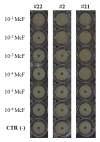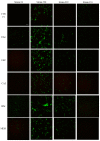Clinical Biofilm Ring Test® Reveals the Potential Role of β-Lactams in the Induction of Biofilm Formation by P. aeruginosa in Cystic Fibrosis Patients
- PMID: 33352641
- PMCID: PMC7766936
- DOI: 10.3390/pathogens9121065
Clinical Biofilm Ring Test® Reveals the Potential Role of β-Lactams in the Induction of Biofilm Formation by P. aeruginosa in Cystic Fibrosis Patients
Abstract
Biofilms are characterized by high tolerance to antimicrobials. However, conventional antibiograms are performed on planktonic microorganisms. Through the clinical Biofilm Ring Test® (cBRT), initially aimed to measure the adhesion propensity of bacteria, we discerned a variable distribution of biofilm-producer strains among P. aeruginosa samples isolated from expectorations of cystic fibrosis (CF) patients. Despite a majority of spontaneous adherent isolates, few strains remained planktonic after 5 h of incubation. Their analysis by an adapted protocol of the cBRT revealed an induction of the biofilm early formation by sub-inhibitory doses of β-lactams. Microscopic observations of bacterial cultures stained with Syto 9/Propidium Iodide (PI) confirmed the ability of antimicrobials to increase either the bacterial biomass or the biovolume occupied by induced sessile cells. Finally, the cBRT and its derivatives enabled to highlight in a few hours the potential inducer property of antibiotics on bacterial adhesion. This phenomenon should be considered carefully in the context of CF since patients are constantly under fluctuating antimicrobial treatments. To conclude, assays derived from the Biofilm Ring Test® (BRT) device, not only define efficient doses preventing biofilm formation, but could be useful for the antimicrobial selection in CF, to avoid inducer molecules of the early biofilm initiation.
Keywords: Pseudomonas aeruginosa; antibiotics; biofilm; clinical Biofilm Ring Test®; cystic fibrosis; early bacterial adhesion induction.
Conflict of interest statement
Authors E.O., C.P., S.B.-B., and J.T. were employed by the companies BioFilm Pharma SAS and BioFilm Control SAS. Author T.B. is the inventor of the BRT device. The remaining authors declare that the research was conducted in the absence of any commercial or financial relationships that could be construed as a potential conflict of interest.
Figures



Similar articles
-
Tobramycin and Amikacin Delay Adhesion and Microcolony Formation in Pseudomonas aeruginosa Cystic Fibrosis Isolates.Front Microbiol. 2017 Jul 11;8:1289. doi: 10.3389/fmicb.2017.01289. eCollection 2017. Front Microbiol. 2017. PMID: 28744274 Free PMC article.
-
The BioFilm Ring Test: a Rapid Method for Routine Analysis of Pseudomonas aeruginosa Biofilm Formation Kinetics.J Clin Microbiol. 2016 Mar;54(3):657-61. doi: 10.1128/JCM.02938-15. Epub 2015 Dec 30. J Clin Microbiol. 2016. PMID: 26719437 Free PMC article.
-
Competition in Biofilms between Cystic Fibrosis Isolates of Pseudomonas aeruginosa Is Shaped by R-Pyocins.mBio. 2019 Jan 29;10(1):e01828-18. doi: 10.1128/mBio.01828-18. mBio. 2019. PMID: 30696740 Free PMC article.
-
Pseudomonas aeruginosa chromosomal beta-lactamase in patients with cystic fibrosis and chronic lung infection. Mechanism of antibiotic resistance and target of the humoral immune response.APMIS Suppl. 2003;(116):1-47. APMIS Suppl. 2003. PMID: 14692154 Review.
-
Clinical Impact of Antibiotics for the Treatment of Pseudomonas aeruginosa Biofilm Infections.Front Microbiol. 2020 Jan 9;10:2894. doi: 10.3389/fmicb.2019.02894. eCollection 2019. Front Microbiol. 2020. PMID: 31998248 Free PMC article. Review.
Cited by
-
The value of biofilm testing to guide antimicrobial stewardship in chronic respiratory diseases.Front Cell Infect Microbiol. 2023 May 2;13:1142274. doi: 10.3389/fcimb.2023.1142274. eCollection 2023. Front Cell Infect Microbiol. 2023. PMID: 37201119 Free PMC article.
-
In vitro inhibition of Pseudomonas aeruginosa PAO1 biofilm formation by DZ2002 through regulation of extracellular DNA and alginate production.Front Cell Infect Microbiol. 2024 Jan 10;13:1333773. doi: 10.3389/fcimb.2023.1333773. eCollection 2023. Front Cell Infect Microbiol. 2024. PMID: 38268790 Free PMC article.
-
Exploring the Diversity of Biofilm Formation by the Food Spoiler Brochothrix thermosphacta.Microorganisms. 2022 Dec 15;10(12):2474. doi: 10.3390/microorganisms10122474. Microorganisms. 2022. PMID: 36557727 Free PMC article.
References
-
- Nathwani D., Raman G., Sulham K., Gavaghan M., Menon V. Clinical and economic consequences of hospital-acquired resistant and multidrug-resistant Pseudomonas aeruginosa infections: A systematic review and meta-analysis. Antimicrob. Resist. Infect. Control. 2014;3:32. doi: 10.1186/2047-2994-3-32. - DOI - PMC - PubMed
LinkOut - more resources
Full Text Sources
Research Materials
Miscellaneous

